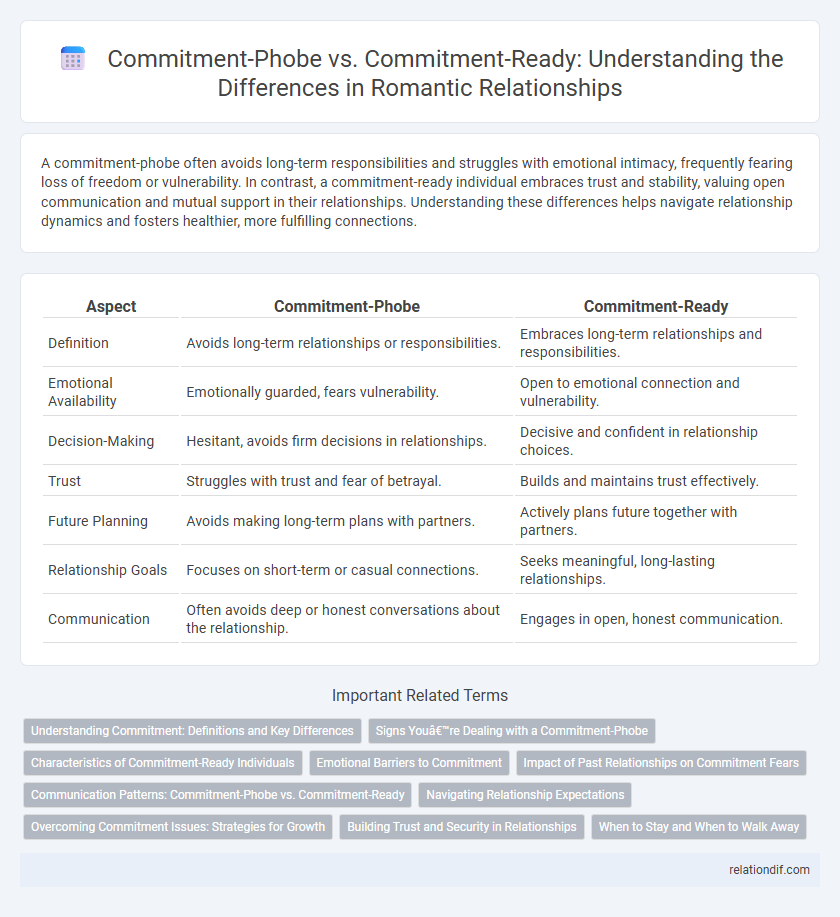A commitment-phobe often avoids long-term responsibilities and struggles with emotional intimacy, frequently fearing loss of freedom or vulnerability. In contrast, a commitment-ready individual embraces trust and stability, valuing open communication and mutual support in their relationships. Understanding these differences helps navigate relationship dynamics and fosters healthier, more fulfilling connections.
Table of Comparison
| Aspect | Commitment-Phobe | Commitment-Ready |
|---|---|---|
| Definition | Avoids long-term relationships or responsibilities. | Embraces long-term relationships and responsibilities. |
| Emotional Availability | Emotionally guarded, fears vulnerability. | Open to emotional connection and vulnerability. |
| Decision-Making | Hesitant, avoids firm decisions in relationships. | Decisive and confident in relationship choices. |
| Trust | Struggles with trust and fear of betrayal. | Builds and maintains trust effectively. |
| Future Planning | Avoids making long-term plans with partners. | Actively plans future together with partners. |
| Relationship Goals | Focuses on short-term or casual connections. | Seeks meaningful, long-lasting relationships. |
| Communication | Often avoids deep or honest conversations about the relationship. | Engages in open, honest communication. |
Understanding Commitment: Definitions and Key Differences
Commitment-phobes often avoid long-term obligations due to fear of loss or vulnerability, while commitment-ready individuals embrace dedication as a pathway to growth and trust. Understanding commitment involves recognizing it as a conscious decision to invest time, energy, and emotions in a person or goal. Key differences lie in emotional readiness, communication patterns, and willingness to sustain challenges for mutual benefit.
Signs You’re Dealing with a Commitment-Phobe
Signs you're dealing with a commitment-phobe include frequent avoidance of long-term plans, inconsistent communication, and reluctance to define the relationship. These individuals often exhibit fear of vulnerability, prioritize personal freedom over partnership, and may display patterns of emotional withdrawal during serious conversations. Recognizing these behaviors early is crucial for understanding relationship dynamics and setting appropriate boundaries.
Characteristics of Commitment-Ready Individuals
Commitment-ready individuals demonstrate emotional availability, consistent communication, and a strong sense of responsibility toward their relationships. They prioritize trust-building, exhibit empathy, and maintain a balanced approach to personal and shared goals. These qualities foster stability and deepen connection, differentiating them from commitment-phobes who avoid emotional investment and long-term obligations.
Emotional Barriers to Commitment
Emotional barriers to commitment often differentiate commitment-phobes from commitment-ready individuals, with fear of vulnerability and past relational trauma being primary obstacles. Commitment-phobes frequently experience anxiety linked to loss of independence and emotional pain, which hinders their ability to form deep connections. In contrast, commitment-ready individuals tend to possess higher emotional resilience and trust, enabling them to embrace long-term relationships despite potential risks.
Impact of Past Relationships on Commitment Fears
Individuals who are commitment-phobic often carry unresolved trauma or negative experiences from past relationships, which significantly heighten their fear of emotional attachment and vulnerability. In contrast, commitment-ready individuals tend to have processed previous relationship challenges, allowing them to approach new partnerships with trust and emotional resilience. The impact of past relationship dynamics, such as betrayal or abandonment, strongly influences one's ability to commit, making emotional healing and self-awareness crucial for overcoming commitment fears.
Communication Patterns: Commitment-Phobe vs. Commitment-Ready
Commitment-phobes often exhibit evasive communication patterns, avoiding discussions about future plans and deflecting emotional conversations to maintain distance. In contrast, commitment-ready individuals engage in open, honest dialogue, expressing feelings clearly and addressing concerns proactively to build trust. These contrasting communication styles fundamentally shape relationship stability and emotional intimacy.
Navigating Relationship Expectations
Commitment-phobes often struggle with consistent emotional availability and fear long-term obligations, leading to fluctuating relationship expectations. Commitment-ready individuals prioritize clear communication, mutual trust, and a shared vision for the future, fostering stability and growth. Understanding these differing mindsets is crucial for navigating relationship dynamics and aligning expectations effectively.
Overcoming Commitment Issues: Strategies for Growth
Overcoming commitment issues involves recognizing the root causes of fear and uncertainty that distinguish commitment-phobes from commitment-ready individuals. Strategies for growth include practicing open communication, setting realistic expectations, and gradually increasing emotional vulnerability to build trust and confidence. Embracing self-awareness and seeking professional support can transform apprehension into a secure, long-lasting commitment mindset.
Building Trust and Security in Relationships
Commitment-ready individuals cultivate trust through consistent communication, reliability, and emotional availability, creating a secure foundation in relationships. In contrast, commitment-phobes often struggle with vulnerability and fear of intimacy, which hinders trust-building and fosters insecurity. Establishing mutual respect and transparency is crucial for transforming uncertainty into lasting emotional security.
When to Stay and When to Walk Away
Commitment-ready individuals recognize signs of mutual respect, shared goals, and emotional support as indicators to stay and build a lasting relationship. Commitment-phobes often spot red flags like inconsistent communication, lack of trust, or incompatible values as signals to walk away before deeper attachment forms. Understanding these psychological and behavioral cues helps each person make informed decisions about when to invest in or leave a relationship.
commitment-phobe vs commitment-ready Infographic

 relationdif.com
relationdif.com